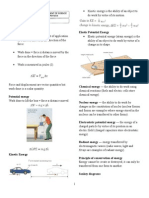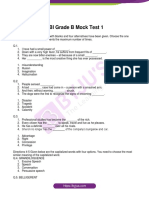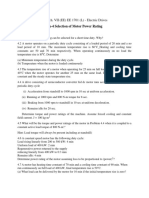Phy130 Tutorial 5 Student
Phy130 Tutorial 5 Student
Uploaded by
Shuhaila Hanis RosliCopyright:
Available Formats
Phy130 Tutorial 5 Student
Phy130 Tutorial 5 Student
Uploaded by
Shuhaila Hanis RosliOriginal Description:
Copyright
Available Formats
Share this document
Did you find this document useful?
Is this content inappropriate?
Copyright:
Available Formats
Phy130 Tutorial 5 Student
Phy130 Tutorial 5 Student
Uploaded by
Shuhaila Hanis RosliCopyright:
Available Formats
AS120/ PHY130 / TUTORIAL 5 / MAC18-JULY18 / NSZ
TUTORIAL 5
WORK, ENERGY AND POWER
1. State the two factors that influence the kinetic energy of a body.
2. An object of mass 0.50 kg is thrown vertically upwards with an initial velociy of 0.8
ms-1. The maximum height by the object is 2.5 m. Compute the work done
against air resistance?(Ans: W= 12.26 J)
3. A boy pulls a 10.0 kg book rack at rest on a smooth floor with a constant
horizontal force of 1.2 N starting from rest.( Ans:i) KE= 6 J; Vf= 1.0954 ms-1)
i. Compute the change in kinetic energy of the box after the boy has pulled it
a distance of 5.0 m.
ii. Compute the final velocity of the box after the boy has pulled it a distance
of 5.0 m.
4. A 5.0 g apple is thrown straight upward with an initial velocity of 20.0 m/s at a
point of 1.5 m height from ground. Ignoring air friction. (Ans:i) ET= 1.074 J; ii) PE=
1.07 J)
i. Calculate the total mechanical energy of the apple at initial position.
ii. Calculate the potential energy of the apple at maximum position.
5. State the two factors that influence the kinetic energy of a body.
6.
Figure 1
A tractor is used to pull a sled loaded with a firewood through a distance of 20 m
along level ground. The total weight of the sled with the load is 14700 N. The
tractor pulls the sled and load at a constant force F of magnitude 5000 N at an
angle of 36.9° above the horizontal as shown in Figure 1. The ground exerts a
friction force Ff of magnitude 3500 N on the sled. Calculate: (Ans: i)WF= 80 kJ,
ii)WFf=-70 kJ)
i. The work done by constant force F.
ii. The work dobe by frictional force Ff.
7.
Figure 2
“The real secret of succes is enthusiasm” Page 1
AS120/ PHY130 / TUTORIAL 5 / MAC18-JULY18 / NSZ
A 4.0 kg bead slides on a curved wire, starting from rest at point A as shown in
Figure 2. The wire is frictionless between points A and B. Determine the kinetic
energy of the bead at B. (Ans: Ek= 11.77 J)
8. State work-energy theorem.
9. Explain the Coservation of Energy
10.
Figure 3
Figure 3 shows a worker pushing a wheelbarrow of mass 40 kg with a constant
velocity along a horizontal surface whose coefficient of friction is 0.5. (Ans:
F=318.5 N; b.W= 2758.3 J)
i. What is the force P exerted by the worker if the θ = 30°?
ii. What is the work done by the worker when the wheelbarrow is pushed
through a distance of 10 m?
11. A person pushes a 10 kg cart a distance of 20 m by exerting a 60 N horizontal
force. The frictional resistance force is 50 N. (Ans: WF = 1200 J, Wf = -1000 J;b.
KE= 200 J)
i. How much work is done by each force acting on the cart?
ii. How much kinetic energy does the cart have at the end of the 20 m if it
started from the rest?
12.
Figure 4
What is the increase in potential energy of a 1 kg body when lifted from the floor
to table 1m high as shown in Figure 4? (Ans: Ep= 9.81 J)
13. A constant force of 15 N is applied to an object of mass 5.0 kg at an angle of 35°
with the horizontal. What is the work done by this force on the object if it causes a
displacement of 1.5 m along the horizontal direction?(Ans: W= 18.43 J)
14.
Figure 5
“The real secret of succes is enthusiasm” Page 2
AS120/ PHY130 / TUTORIAL 5 / MAC18-JULY18 / NSZ
Figure 5 shows a skater travelling at 15 m/s at the foot of a 20° inclined plane
continues to skate up 12.8 m up the slope before coming to a stop. Find the
coefficient of friction between the plane with the skater. (Ans: µ = 0.55 )
15. A 490 N sled is dragged for 12 s along a horizontal path with a constant speed of
1.8 m/s by a rope inclined 35° above the horizontal. Given that the tension in the
rope is 280 N, calculate
i. The distance travelled by the sled [Ans: s = 21.6 m]
ii. The work done by the rope on the sled [Ans: a= 1.67 ms-2]
16. A 155 g baseball is thrown up with a speed of 28 m/s. Find the work done on the
baseball against gravity to reach its maximum height.(Ans: W= -60.76J)
17.
Figure 7
Figure 7 shows a bead slidings on a wire. If friction forces are negligible and the
bead has a velocity of 300 cm/s at A, compute its speed at [Ans:i. VB = 4.768 ms-
1 ; ii. V = 3.311 ms-1
c
i. point B
ii. point C
18. Calculate the average horsepower required to raise a 150 kg drum to a height of
20 m in a time of 1.0 minute. [Ans:P= 490.5 Watt]
19. An engine expends 29.828 kW in propelling a car along a level track at 15.0 ms -1.
Compute the total retarding force acting on the car. [Ans: F= 1.99 kN]
20. A 900 kg car whose motor delivers maximum power of 40.0 h.p to its wheels can
maintain a steady speed of 130 km/h on a horizontal roadway. How large is the
friction force that impedes its motion a this speed? [Ans:Ff= 826 N]
“The real secret of succes is enthusiasm” Page 3
You might also like
- TB Chapter7 PDFDocument24 pagesTB Chapter7 PDFAsmaa AhmedNo ratings yet
- Work, Energy and Power Cambridge OLDocument14 pagesWork, Energy and Power Cambridge OLSuresh SenanayakeNo ratings yet
- Caluse of IEC 61840 For Test On MV CableDocument4 pagesCaluse of IEC 61840 For Test On MV CableInayat Hathiari50% (2)
- Lab Report of The Thermal ConductivityDocument9 pagesLab Report of The Thermal ConductivitySalam Albaradie88% (16)
- Tutorial Phy110 Week12 - Chapter 6 - Part 1Document4 pagesTutorial Phy110 Week12 - Chapter 6 - Part 1arissa 0503No ratings yet
- Tutorial Das14103 - Chapter 6Document4 pagesTutorial Das14103 - Chapter 6Najiha SufianNo ratings yet
- Absolute Dependent Motion Analysis of Two ParticlesDocument57 pagesAbsolute Dependent Motion Analysis of Two ParticlesFrancis Philippe Cruzana CariñoNo ratings yet
- Work Sheet G9 Unit 3&4Document2 pagesWork Sheet G9 Unit 3&4Amarch BahiluNo ratings yet
- Tutorial 5 Force and MotionDocument4 pagesTutorial 5 Force and MotionNadhirah Kaspol AnuarNo ratings yet
- Ch8 Review Problems NewDocument6 pagesCh8 Review Problems NewVic VanceNo ratings yet
- Uploads563856384743unit 3 Work Energy Power Practice Questions 2019 PDFDocument6 pagesUploads563856384743unit 3 Work Energy Power Practice Questions 2019 PDFRolando TorresNo ratings yet
- Chapter 5: Work, Energy and PowerDocument4 pagesChapter 5: Work, Energy and PowerPriyaa JayasankarNo ratings yet
- Wpe ExercisesDocument11 pagesWpe ExercisesjoeNo ratings yet
- Unit 3 Work Energy Power Practice Questions v2 2016 AnswersDocument6 pagesUnit 3 Work Energy Power Practice Questions v2 2016 AnswersJane CongaoNo ratings yet
- Pisiks 71 Prob SetsDocument8 pagesPisiks 71 Prob SetsAndroNo ratings yet
- PHYCS101 - Test2 RevisionDocument8 pagesPHYCS101 - Test2 RevisionAli MaarajNo ratings yet
- Three Identical BallsDocument5 pagesThree Identical BallsharshanauocNo ratings yet
- CH 8 - Energy & WorkDocument23 pagesCH 8 - Energy & WorkJonni Maruli Tua SitorusNo ratings yet
- 6B Physics - WPEDocument3 pages6B Physics - WPEDanielle MullingsNo ratings yet
- Chapter 7-Work, Energy UpdatedDocument43 pagesChapter 7-Work, Energy UpdatedNoor BlNo ratings yet
- Phys10 Chap6 Work&KineticEnergyDocument5 pagesPhys10 Chap6 Work&KineticEnergyEngelbert Bicoy Antod100% (1)
- WORKDocument43 pagesWORKmailforprinting101No ratings yet
- Work and EnergyDocument124 pagesWork and Energyjack100% (1)
- At The End of This Session, Students Will Be Able To 1. Understand Kinetics of Rigid Body. 2.relate Between Force, Mass & Acceleration. 3.solve Relevant ProblemsDocument22 pagesAt The End of This Session, Students Will Be Able To 1. Understand Kinetics of Rigid Body. 2.relate Between Force, Mass & Acceleration. 3.solve Relevant ProblemsrajeswariNo ratings yet
- PROBLEM - SOLVING - Friction and 2nd Law UstDocument34 pagesPROBLEM - SOLVING - Friction and 2nd Law UstMarj Ladica MangaNo ratings yet
- LawsofMotion Paper 05Document8 pagesLawsofMotion Paper 05Brajesh GautamNo ratings yet
- Tutorial Sheet - 5Document2 pagesTutorial Sheet - 5chewe chewe100% (1)
- Sheet Two Chapter Three The Laws of MotionDocument24 pagesSheet Two Chapter Three The Laws of MotionTony AtefNo ratings yet
- PS#7 Due05302024Document4 pagesPS#7 Due05302024inluculentNo ratings yet
- Work Energy Worksheet PacketDocument14 pagesWork Energy Worksheet PacketSara Afzal0% (1)
- WorkDocument5 pagesWorkRoriel Hernandez BenamirNo ratings yet
- Work Energy Power Class Notes and Example ProblemsDocument10 pagesWork Energy Power Class Notes and Example ProblemsMikiyo bestNo ratings yet
- Exercise: Chapter 4Document2 pagesExercise: Chapter 4Lorenzo YapNo ratings yet
- 17 B Energy Power Work SolutionsDocument2 pages17 B Energy Power Work SolutionsMark Cidric RoqueroNo ratings yet
- C5-Work and EnergyDocument6 pagesC5-Work and EnergyHisyammudin RoslanNo ratings yet
- Additional Sample ProblemsDocument5 pagesAdditional Sample ProblemsMarifer CavintaNo ratings yet
- Worksheet Unit1Document4 pagesWorksheet Unit1RajeshKumarNo ratings yet
- Work Energy Worksheet 1Document5 pagesWork Energy Worksheet 1TheOnesNo ratings yet
- Chapter 9 - Work and Kinetic EnergyDocument4 pagesChapter 9 - Work and Kinetic Energymasilojack5No ratings yet
- Exam Questions: Energy (Grade 11 Level)Document11 pagesExam Questions: Energy (Grade 11 Level)Onur YavuzcetinNo ratings yet
- Review Problems, Physics 111 Final ExamDocument13 pagesReview Problems, Physics 111 Final Examav742No ratings yet
- WEP Energy Question BankDocument2 pagesWEP Energy Question BankAJ SkybornNo ratings yet
- Work, Power Energy Q&ADocument93 pagesWork, Power Energy Q&ADebalina DassNo ratings yet
- Work Energy Power 1Document4 pagesWork Energy Power 1Gaming baseNo ratings yet
- Adv Work Energy Practice ProblemsDocument11 pagesAdv Work Energy Practice ProblemsZanduarNo ratings yet
- Work Energy Power and Efficiency IB WorksheetDocument12 pagesWork Energy Power and Efficiency IB WorksheetAnonymous LZmFaXc100% (2)
- Lesson 10 Work Potential and Kinetic EnergyDocument6 pagesLesson 10 Work Potential and Kinetic EnergydudoocandrawNo ratings yet
- 6-Work, Power & EnergyDocument5 pages6-Work, Power & Energytanujbera2008No ratings yet
- Chapter 5 - Work, Energy PowerDocument34 pagesChapter 5 - Work, Energy PowerncmzcnmzzNo ratings yet
- (Physics) AnswersDocument15 pages(Physics) AnswersLoraine Rose EstivaNo ratings yet
- Tutorial Work, Energy and PowerDocument5 pagesTutorial Work, Energy and PowerAimeenul AzfarNo ratings yet
- Unit 11 Moments 1Document5 pagesUnit 11 Moments 1Kesha DilworthNo ratings yet
- Ch6. Work and Energy Work Done by A Constant ForceDocument93 pagesCh6. Work and Energy Work Done by A Constant ForceKtel R MacarioNo ratings yet
- Example Sheet 2 QuestionsDocument2 pagesExample Sheet 2 QuestionsTrevor LewisNo ratings yet
- Padilla Karl Aaron D. EN1 4STEMDocument25 pagesPadilla Karl Aaron D. EN1 4STEMKurt Allen PadillaNo ratings yet
- Work Power EnergyDocument9 pagesWork Power EnergySanmati Jain100% (1)
- Physics 122 Problem SetDocument86 pagesPhysics 122 Problem SetCarmen DraghiaNo ratings yet
- BotaniName PDFDocument17 pagesBotaniName PDFShuhaila Hanis RosliNo ratings yet
- Bio103 - Biology TEST 1 (30 Marks)Document1 pageBio103 - Biology TEST 1 (30 Marks)Shuhaila Hanis RosliNo ratings yet
- Fundamental of Physics I: Laboratory ReportDocument1 pageFundamental of Physics I: Laboratory ReportShuhaila Hanis RosliNo ratings yet
- Ridge National Laboratory: Thermal Properties of Wood Panel Products Buildings Wood and For Use inDocument57 pagesRidge National Laboratory: Thermal Properties of Wood Panel Products Buildings Wood and For Use inShuhaila Hanis RosliNo ratings yet
- Phy130 Tutorial 9Document3 pagesPhy130 Tutorial 9Shuhaila Hanis RosliNo ratings yet
- Phy130-Tutorial 7 PDFDocument2 pagesPhy130-Tutorial 7 PDFShuhaila Hanis RosliNo ratings yet
- Phy130 Tutorial 8Document3 pagesPhy130 Tutorial 8Shuhaila Hanis RosliNo ratings yet
- Phy130 Tutorial 4Document6 pagesPhy130 Tutorial 4Shuhaila Hanis Rosli100% (1)
- Phy130 Tutorial 8Document3 pagesPhy130 Tutorial 8Shuhaila Hanis RosliNo ratings yet
- Phy130 Tutorial 4Document2 pagesPhy130 Tutorial 4Shuhaila Hanis RosliNo ratings yet
- Phy130 Tutorial 8Document3 pagesPhy130 Tutorial 8Shuhaila Hanis RosliNo ratings yet
- Phy130 Tutorial 1Document2 pagesPhy130 Tutorial 1Shuhaila Hanis RosliNo ratings yet
- Jee Main Sample Paper 1 - 2020 Physics Question Paper: IndiaDocument7 pagesJee Main Sample Paper 1 - 2020 Physics Question Paper: IndiaL.ABHISHEK KUMARNo ratings yet
- Wiring Digram For ACDocument3 pagesWiring Digram For ACahmed HOSNYNo ratings yet
- On Job Training at Tanjung Bin Power Plant Erick ImmanuelDocument40 pagesOn Job Training at Tanjung Bin Power Plant Erick ImmanuelFabi FahrizalNo ratings yet
- A Microproject Report On: Institute of Civil and Rural EngineeringDocument15 pagesA Microproject Report On: Institute of Civil and Rural EngineeringPranil KambleNo ratings yet
- RBI Grade B Mock Test 1Document7 pagesRBI Grade B Mock Test 1TristanNo ratings yet
- 322C Excavator Electrical System: Machine Harness Connector and Component LocationsDocument2 pages322C Excavator Electrical System: Machine Harness Connector and Component LocationsLuis Gabriel MartinezNo ratings yet
- Multiple Choice Questions For Science English Class X PDFDocument62 pagesMultiple Choice Questions For Science English Class X PDFShweta SaraswatNo ratings yet
- Tehnički List ProizvodaDocument1 pageTehnički List ProizvodaTomislav LoinaNo ratings yet
- Lesson 1.2 - Exergy Evaluation On Engineering ProcessesDocument44 pagesLesson 1.2 - Exergy Evaluation On Engineering ProcessesBilly JhunNo ratings yet
- Alternator by Emf MethodDocument7 pagesAlternator by Emf MethodsakthipriyaNo ratings yet
- PHYS22 GF 01 Skills WorkbookDocument4 pagesPHYS22 GF 01 Skills WorkbookSamah MohamedNo ratings yet
- SOFARSOLAR HYD3-6KW - User Manual - 190219Document43 pagesSOFARSOLAR HYD3-6KW - User Manual - 190219MiguelNo ratings yet
- Wind TurbineDocument11 pagesWind TurbineMuhammad Rizwan QureshiNo ratings yet
- Chapter 3 Change of State: Multiple-Choice QuestionsDocument63 pagesChapter 3 Change of State: Multiple-Choice Questionssuperpooh-1No ratings yet
- Heat ExchangersDocument29 pagesHeat Exchangersprotoscope photographyNo ratings yet
- Power Your Future LR6A3L-15 YTO Generator LG100YTO-S2Document3 pagesPower Your Future LR6A3L-15 YTO Generator LG100YTO-S2NoerNo ratings yet
- Design of Rectangular Combined FootingDocument6 pagesDesign of Rectangular Combined FootingJose GranadosNo ratings yet
- LN LCSC P/N Mfr. P/N Order QTY. Cantidad ActualDocument3 pagesLN LCSC P/N Mfr. P/N Order QTY. Cantidad ActualJuan Camilo Guarnizo BermudezNo ratings yet
- Test Report For: CT TestsDocument4 pagesTest Report For: CT TestsAhmed FathyNo ratings yet
- Electronics 05 00018Document18 pagesElectronics 05 00018lohithNo ratings yet
- Design of 2 MW Power Plant Using Renewable Energy For LUBELCO Lubang Islands RevisedDocument60 pagesDesign of 2 MW Power Plant Using Renewable Energy For LUBELCO Lubang Islands RevisedVandrix Odeza Gaspar100% (1)
- Geothermal Value Chain AnalysisDocument23 pagesGeothermal Value Chain AnalysisShipra RajputNo ratings yet
- SSCE1993 Tutorial 1Document14 pagesSSCE1993 Tutorial 1jinNo ratings yet
- Lecture 8-Binary DistillationDocument18 pagesLecture 8-Binary DistillationWasim NawazNo ratings yet
- Ed 4Document2 pagesEd 4Vaibhav KumarNo ratings yet
- CH 20 ExercisesDocument1 pageCH 20 ExercisesPaul BryanNo ratings yet
- Ieee White Paper Current Limiting Arc Flash Quenching System For Improve...Document7 pagesIeee White Paper Current Limiting Arc Flash Quenching System For Improve...Gustavo GamezNo ratings yet
- Automatic Room Control Lighthalf DoneDocument9 pagesAutomatic Room Control Lighthalf DoneRudransh RaghorteNo ratings yet




































































































